
views
Rehydrating Cut Roses
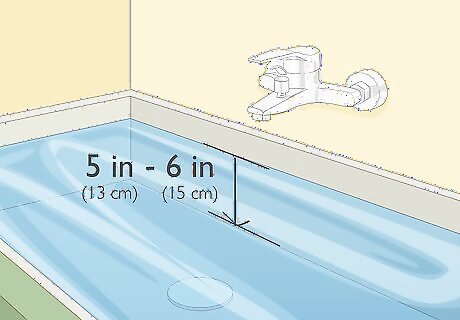
Fill a clean bathtub or sink with enough warm water to cover the roses. Stop up the drain and turn on the warm water tap to fill a sink or bathtub with enough water to cover the roses. The temperature of the water should be lukewarm or a little hotter. About 5 inches (13 cm) to 6 inches (15 cm) of water should do it. Make sure your bathtub or sink is free of grime and soaps before you fill it with water for the rose bath.
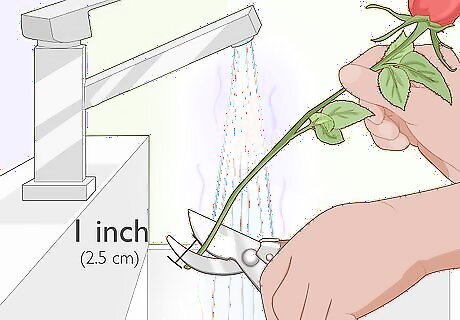
Recut the stems at an angle under warm running water. Turn on the faucet until you have a stream of warm water. Position the stem under the stream and use garden shears to slice off at least 1 inch (2.5 cm) of the stem at a diagonal angle. The diagonal angle allows the stem to take in more water. Cutting the stems under warm running water prevents air bubbles from stopping up the stem's tissues responsible for taking in water. If you're bathing the roses in the sink, use a different sink to recut them or, if possible, use the other side of the sink.
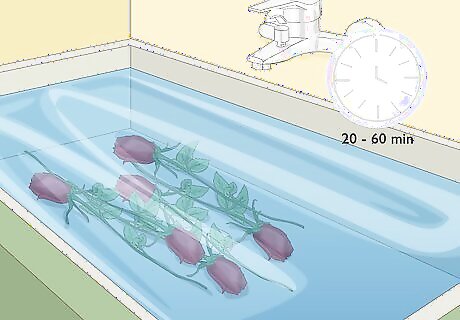
Submerge the roses in the warm water bath for about 20 to 60 minutes. Place each stem horizontally into the bath and push them down so that each rose (the heads included) are fully submerged in the water. This may not revive your roses if they're extremely wilted, especially if the neck shows any signs of shriveling. The idea is that the roses will absorb enough water to be revived.
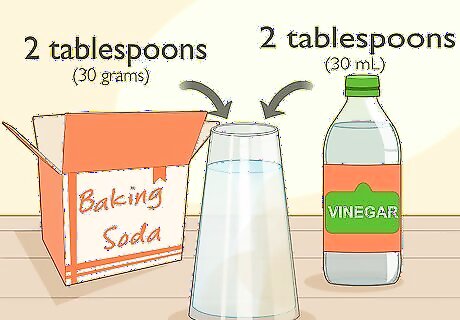
Clean the vase with a mixture of vinegar and baking soda. Pour out the soiled water and then refill it to just above the water line with tap water, 2 tablespoons (29.6 ml) (30 grams) of baking soda, and 2 tablespoons (30 mL) of white vinegar. Let it fizz and settle for about 30 minutes before wiping away any film with a cloth or bottle brush. Thoroughly rinse the vase before you use it again. It's important to keep the vase clean so any bacteria doesn't block the stems from taking in water. If necessary, pour in about 1/4 cup (32 grams) of uncooked rice in the vase to help scrub down the sides.
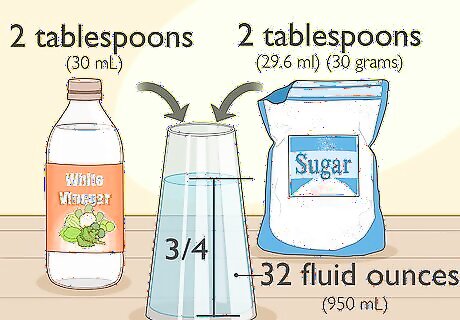
Fill the clean vase 3/4 full with warm water and flower preservative. Fill the vase with tap water and then pour in a packet of flower preservative. If you bought your roses or had them delivered, they probably came with a packet of flower food. If you need more, you can buy flower preservative (AKA flower feed or flower food) at any floral shop or grocery store that has a nursery. The roses can take in warm water better than cold water. You can also make your own flower food by using 2 tablespoons (30 mL) of white vinegar and 2 tablespoons (29.6 ml) (30 grams) of sugar for each 32 fluid ounces (950 mL) of water.
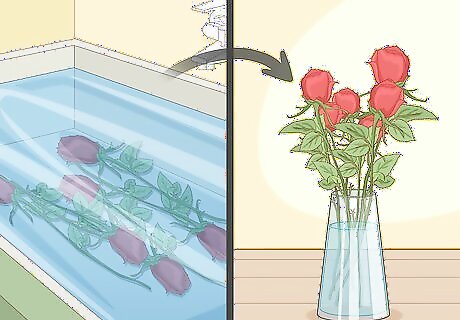
Transfer the roses into the clean vase. Carefully replace each stem 1 or 2 at a time. If the heads are starting to bend, carefully cradle them with your free hand while you replace them. Make sure the roses are placed as vertically as possible to prevent the heads from drooping any further.
Maintaining Cut Roses

Use garden shears to re-cut the ends at a 45-degree angle every 2 days. Fill a bowl with warm water or hold the stems under warm running water as you snip off 1 inch (2.5 cm) from the end of the stem. Cut it at a 45-degree angle to increase the surface area of the stem, allowing the rose to take in more water. You don’t have to snip them under water, but it helps keep air bubbles out of stem and, as a result, increasing the amount of water the rose can absorb. If the stems are super thick and woody, use a pair of sharp garden shears. Avoid using regular scissors or dull blades because they can crush the base of the stem and decrease how much water it can take in.
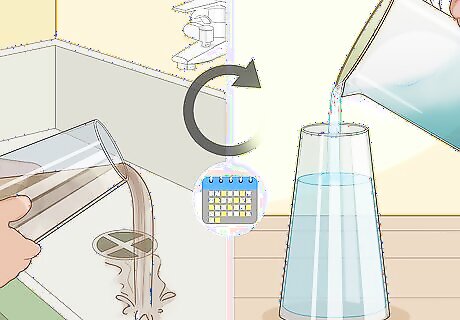
Change out the water every day. Transfer the roses to a clean vase filled with water. Wash the vase in hot, soapy water and rinse it well before refilling it with tap water and replacing the roses. If there is grime or film stuck on the sides of the vase, you may want to soak it with water, vinegar, and baking soda for 1 to 2 hours. If your tap water is extra soft, you may want to use distilled water because soft water has higher sodium (which isn’t good for roses). To do a soak, fill up the vase with hot water and add 2 tablespoons (29.6 ml) (30 grams) of baking soda and 2 tablespoons (30 mL) of white vinegar. Let it sit for 1 to 2 hours before wiping the inside with a scrub brush or sponge.

Remove any leaves below the water line. If your roses have leaves near the base of the stem, take those off to ensure they don’t grime up the water with bacteria. Pluck them off with your fingers or use sharp garden shears to clip them off. Remove any leaves or petals that may have fallen into the water because they can release bacteria and plug up the stem.

Add flower food or bleach to kill any bacteria that may be in the water. Sprinkle in the recommended amount of flower food or pour in 1 teaspoon (4.9 mL) of bleach per 16 fluid ounces (470 mL) of water to prevent bacteria from stopping up the stems. If your roses came with a packet of flower food, look at the back of the package to determine how much to use. The amount of flower food you should use typically depends on the amount of water in the vase. Place an opened packet of flower food in a plastic zipper bag and store it in a cool, dry place.

Place your roses out of direct sunlight and away from drafts and heat. Put the roses in a spot that is 65°F to 72°F (18°C to 22°C) and gets medium to low indirect light. Keep them away from vents, fans, radiators, televisions, and stoves because drafts and heat will dehydrate the roses. If you live in an area with warm days and cool night, avoid placing your roses where the petals or foliage are touching a window. The hot and cool temperature of the glass can damage the leaves. Avoid putting the roses in a place where they’ll be exposed to direct sunlight, like a window sill.
Reinvigorating Rose Bushes
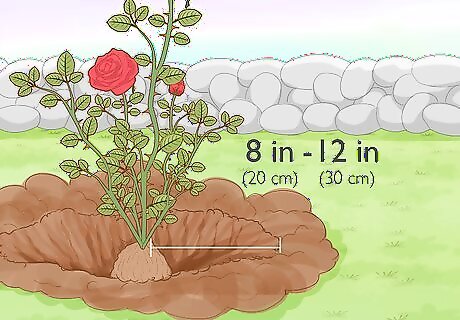
Use a shovel to dig up the area around the entire plant. Place a shovel into the dirt about 8 inches (20 cm) to 12 inches (30 cm) away from the base of the plant to make sure you don’t sever the root system. Do this 4 or 5 times on each side of the plant until you can wiggle and lift the entire plant with ease. Once it’s uprooted, the plant will pop out of the ground and rest on its side. If you discover the roots of the plant are eaten away by pests, don’t worry—it may still live even with a few hairs of the root system left intact.
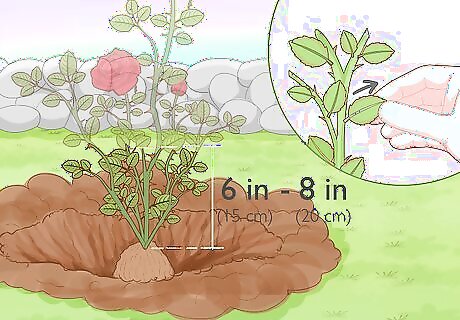
Trim down the stems and pick off the leaves. Use garden shears to trim down each of the rose canes until they’re just 6 inches (15 cm) to 8 inches (20 cm) long. Use your fingers to pick off all of the leaves. Think of this as a reset-button for the plant, cleansing it of any bacteria that may have infected the leaves and stems and caused the plant to suffer.
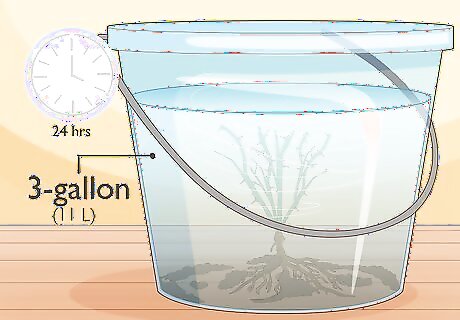
Soak the plant for 24 hour in a large bucket of water. Fill up a 3-gallon (11 L) bucket with water and place the plant in it with the roots facing down. Wait a day before you transplant it into a new pot with fresh soil. Soaking the roots will help rehydrate and reinvigorate the plant’s cells.

Fill a large pot 1/3 of the way full with potting soil and transfer the plant. Use good store-bought potting soil especially made for roses. After you’ve laid the soil base for the bush, place the bush into the soil deep enough to station it into place. You can buy quality potting soil at any garden supply store or plant nursery. Some potting soil contain different minerals and vary in pH levels depending on the flowers they’re made for, so be sure to choose one that specifies it’s best or roses.
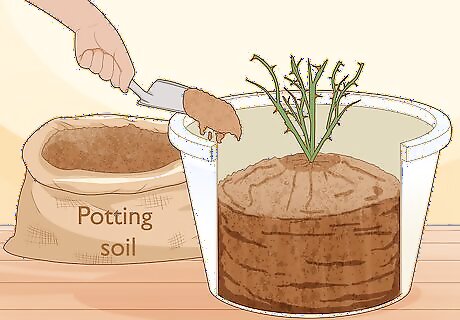
Add more soil to cover the entire root system. Pour more potting soil evenly around the pot until the entire root system is covered. The top of the soil should come up to the base of the rose canes (the thick, bottom ends of each stem system). Make sure the soil is evenly distributed around the plant. Pat down the soil once you’re finished. If it doesn’t cover the root system, add more.
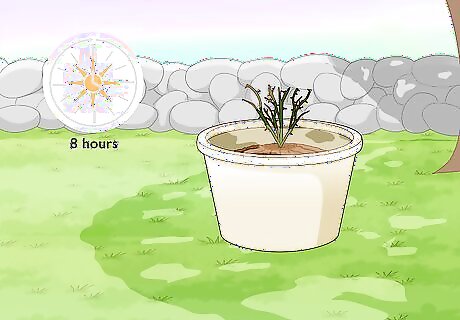
Place the pot in an area where it gets mostly shade or spotty sunlight. Put the potted rose bush under a tree or shaded area that will get mostly shade and some dappled sunlight throughout the day. An area that gets about 8 hours of speckled light is perfect. If you have a greenhouse, place the pot in there because it will provide some shade and the humidity will keep the soil nice and moist.
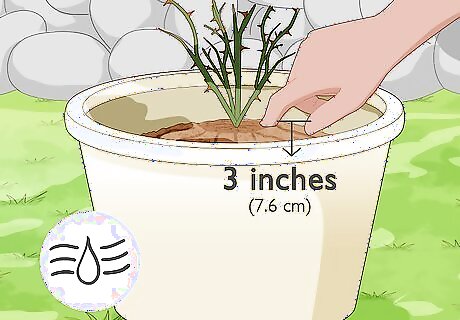
Water the rose bush every other day to keep the soil moist. Check for moisture by sticking your finger down into the top 3 inches (7.6 cm) of the soil or using a soil moisture meter. If it’s damp, there’s no need to water. If you’re using a soil moisture meter, you should water when the meter shows that 50% of the soil is dry. To avoid over-watering, pour in 32 fluid ounces (950 mL) of water at a time and let it settle through the soil so you can gauge how much more you need to add. If you see water trickling out of the base of the pot, the soil is fully saturated and you should stop watering.
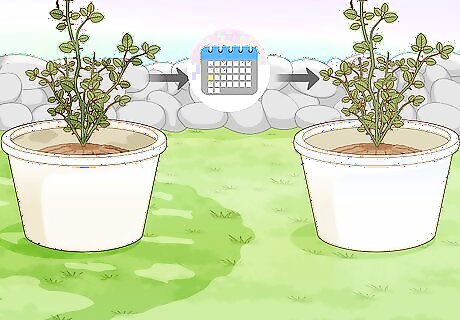
Move the pot to an area that gets mostly sunlight after 2 weeks. Once the root system has stabilized with a little spotty sunlight, move the pot to a place that gets mostly sunlight throughout the day. You can even place it next to the spot where you plan to replant the bush, if you choose to do so. Certain varieties of roses do better with less sun, so check which kind yours are to figure out the best spot for them.




















Comments
0 comment